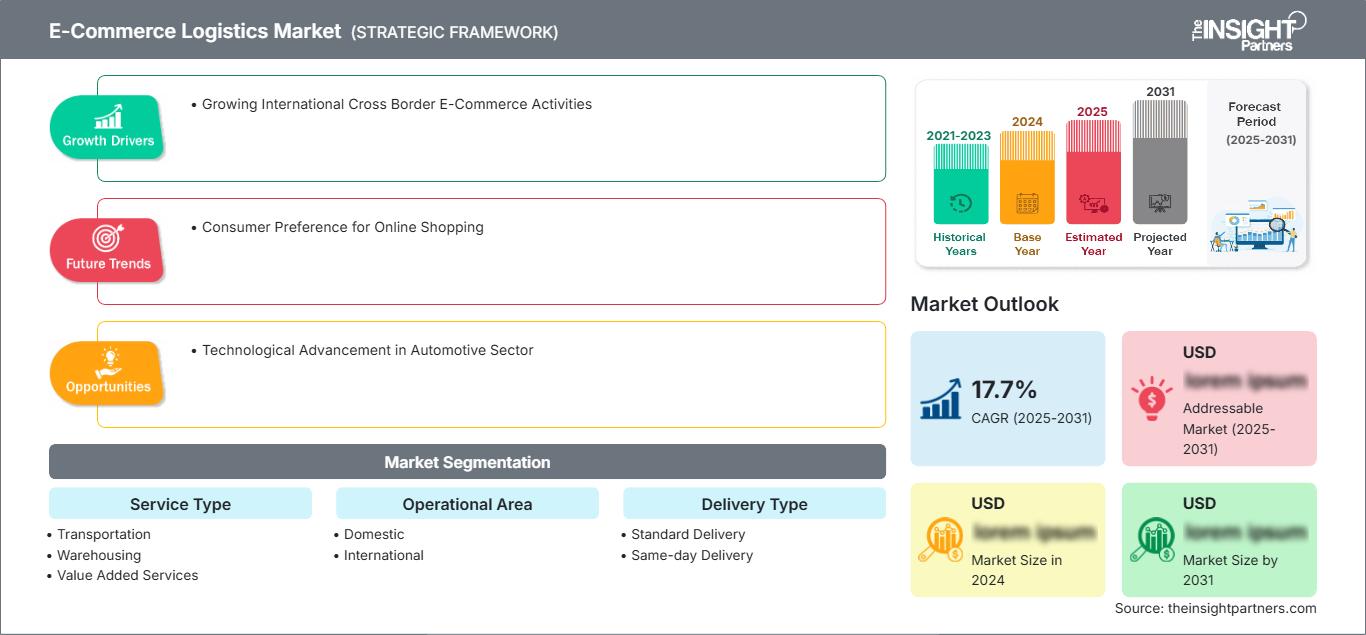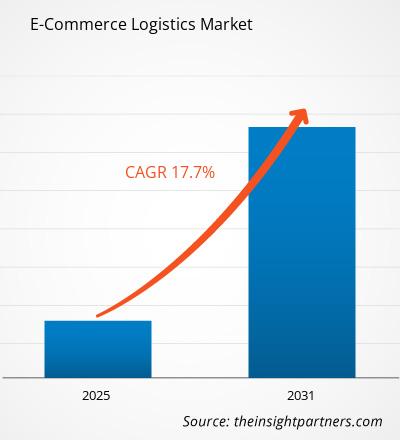Si prevede che il mercato della logistica dell'e-commerce registrerà un CAGR del 17,4% dal 2025 al 2031, con una dimensione del mercato in espansione da XX milioni di dollari nel 2023 a XX milioni di dollari entro il 2031.
Il rapporto è segmentato per tipo di servizio (trasporto, magazzinaggio, servizi a valore aggiunto); area operativa (nazionale, internazionale); tipo di consegna (consegna standard, consegna in giornata); categoria (abbigliamento e lifestyle, automotive, libri e periodici, ingegneria, beni di largo consumo ed elettronica di consumo, sanità, alta tecnologia, altri); utente finale (B2B, B2C). L'analisi globale è ulteriormente suddivisa a livello regionale e per i principali paesi. Il rapporto offre il valore in USD per l'analisi e i segmenti sopra indicati.
Scopo del rapporto
Il rapporto E-Commerce Logistics Market di The Insight Partners mira a descrivere il panorama attuale e la crescita futura, i principali fattori trainanti, le sfide e le opportunità. Ciò fornirà spunti a vari stakeholder aziendali, come:
- Fornitori/produttori di tecnologia: per comprendere le dinamiche di mercato in evoluzione e conoscere le potenziali opportunità di crescita, consentendo loro di prendere decisioni strategiche informate.
- Investitori: per condurre un'analisi completa delle tendenze in merito al tasso di crescita del mercato, alle proiezioni finanziarie del mercato e alle opportunità esistenti lungo la catena del valore.
- Organismi di regolamentazione: per regolamentare le politiche e le attività di polizia nel mercato con l'obiettivo di ridurre al minimo gli abusi, preservare la fiducia degli investitori e sostenere l'integrità e la stabilità del mercato.
Tipo di servizio di segmentazione del mercato della logistica dell'e-commerce
- Trasporti
- Magazzinaggio
- Servizi a valore aggiunto; Area operativa
Tipo di consegna
- Consegna standard
- Consegna in giornata
Categoria
- Abbigliamento e stile di vita
- Automotive
- Libri e periodici
- Ingegneria
- FMCG ed elettronica di consumo
- Sanità
- Alta tecnologia
- Altro
Area operativa
- Nazionale
- Internazionale
Utente finale
- B2B
- B2C
Personalizza questo rapporto in base alle tue esigenze
Potrai personalizzare gratuitamente qualsiasi rapporto, comprese parti di questo rapporto, o analisi a livello di paese, pacchetto dati Excel, oltre a usufruire di grandi offerte e sconti per start-up e università
Mercato della logistica dell'e-commerce: Approfondimenti strategici

-
Ottieni le principali tendenze chiave del mercato di questo rapporto.Questo campione GRATUITO includerà l'analisi dei dati, che vanno dalle tendenze di mercato alle stime e alle previsioni.
Fattori di crescita del mercato della logistica dell'e-commerce
- Boom delle vendite dell'e-commerce: la rapida crescita degli acquisti online è un fattore trainante per il mercato della logistica dell'e-commerce. Con un numero sempre maggiore di consumatori che si rivolgono a piattaforme digitali per l'acquisto di beni, la domanda di soluzioni logistiche efficienti, veloci e affidabili è aumentata. Ciò include tempi di consegna più rapidi, gestione ottimizzata dell'inventario e servizi di consegna dell'ultimo miglio migliorati, tutti fattori che alimentano l'espansione del settore logistico.
- Progressi tecnologici: innovazioni tecnologiche come l'intelligenza artificiale, la robotica e l'automazione stanno trasformando la logistica dell'e-commerce. Queste tecnologie semplificano l'immagazzinamento, la gestione dell'inventario e l'evasione degli ordini, migliorando l'efficienza e riducendo i costi. L'integrazione di sistemi basati sull'intelligenza artificiale per l'ottimizzazione dei percorsi e l'analisi predittiva sta ulteriormente migliorando le prestazioni operative.
- Richiesta dei consumatori di consegne più rapide: la crescente aspettativa di consegne più rapide, comprese le spedizioni in giornata e il giorno successivo, sta determinando la necessità di reti logistiche più efficienti. Per soddisfare queste esigenze, le aziende di logistica stanno investendo in modelli di consegna innovativi e in aggiornamenti infrastrutturali, come i micro-centri di evasione degli ordini, per migliorare la velocità e la soddisfazione del cliente.
Trend futuri del mercato logistico dell'e-commerce
- Ascesa dell'evasione degli ordini omnicanale: la tendenza verso l'evasione degli ordini omnicanale, in cui i rivenditori di e-commerce offrono opzioni di acquisto sia online che in negozio, sta rimodellando il mercato della logistica. I rivenditori stanno investendo in sistemi integrati per garantire una consegna fluida su più canali, migliorando l'esperienza dei clienti e stimolando la domanda di soluzioni logistiche avanzate che si rivolgono sia all'e-commerce che al commercio al dettaglio tradizionale.
- Sostenibilità e logistica verde: la sostenibilità sta diventando un obiettivo chiave nella logistica dell'e-commerce. Le aziende stanno dando priorità a pratiche ecocompatibili, come veicoli di consegna elettrici, spedizioni a zero emissioni di carbonio e riduzione degli imballaggi. Con la crescente attenzione all'ambiente da parte dei consumatori, i fornitori di servizi logistici si stanno adattando per soddisfare la domanda di soluzioni di spedizione più ecologiche e sostenibili.
Opportunità di mercato per la logistica dell'e-commerce
- Espansione delle soluzioni di consegna dell'ultimo miglio: la consegna dell'ultimo miglio rappresenta un'opportunità significativa nella logistica dell'e-commerce. Con la crescente domanda di consegne più rapide, soluzioni innovative per l'ultimo miglio, come droni, veicoli autonomi e hub di consegna locali, offrono alle aziende di logistica l'opportunità di migliorare l'efficienza delle consegne riducendo al contempo i costi e l'impatto ambientale.
- Crescita dell'e-commerce transfrontaliero: con la continua espansione dell'e-commerce transfrontaliero, le aziende di logistica hanno l'opportunità di accedere ai mercati internazionali. Offrire soluzioni di spedizione ottimizzate e affidabili che consentano di superare le sfide doganali, tariffarie e di spedizione globale può aiutare i fornitori di servizi logistici a capitalizzare sulla crescente domanda di servizi di e-commerce globali.
Approfondimenti regionali sul mercato della logistica dell'e-commerce
Le tendenze e i fattori regionali che influenzano il mercato della logistica per l'e-commerce durante il periodo di previsione sono stati ampiamente spiegati dagli analisti di The Insight Partners. Questa sezione analizza anche i segmenti e la geografia del mercato della logistica per l'e-commerce in Nord America, Europa, Asia-Pacifico, Medio Oriente e Africa, America meridionale e centrale.
Ambito del rapporto sul mercato della logistica dell'e-commerce
| Attributo del rapporto | Dettagli |
|---|---|
| Dimensioni del mercato in 2024 | US$ XX million |
| Dimensioni del mercato per 2031 | US$ XX Million |
| CAGR globale (2025 - 2031) | 17.7% |
| Dati storici | 2021-2023 |
| Periodo di previsione | 2025-2031 |
| Segmenti coperti |
By Tipo di servizio
|
| Regioni e paesi coperti |
Nord America
|
| Leader di mercato e profili aziendali chiave |
|
Densità degli operatori del mercato logistico dell'e-commerce: comprendere il suo impatto sulle dinamiche aziendali
Il mercato della logistica per l'e-commerce è in rapida crescita, trainato dalla crescente domanda degli utenti finali dovuta a fattori quali l'evoluzione delle preferenze dei consumatori, i progressi tecnologici e una maggiore consapevolezza dei vantaggi del prodotto. Con l'aumento della domanda, le aziende stanno ampliando la propria offerta, innovando per soddisfare le esigenze dei consumatori e sfruttando le tendenze emergenti, alimentando ulteriormente la crescita del mercato.

- Ottieni il Mercato della logistica dell'e-commerce Panoramica dei principali attori chiave
Punti di forza
- Copertura completa: il rapporto analizza in modo esaustivo prodotti, servizi, tipologie e utenti finali del mercato della logistica per l'e-commerce, offrendo una panoramica olistica.
- Analisi degli esperti: il rapporto è redatto sulla base della profonda conoscenza di esperti e analisti del settore.
- Informazioni aggiornate: il rapporto garantisce la pertinenza aziendale grazie alla copertura di informazioni e tendenze dei dati più recenti.
- Opzioni di personalizzazione: questo rapporto può essere personalizzato per soddisfare le esigenze specifiche del cliente e adattarsi in modo appropriato alle strategie aziendali.
Il rapporto di ricerca sul mercato della logistica per l'e-commerce può quindi aiutare a guidare il percorso di decodificazione e comprensione dello scenario del settore e delle prospettive di crescita. Sebbene possano esserci alcune valide preoccupazioni, i vantaggi complessivi di questo rapporto tendono a superare gli svantaggi.
- Analisi storica (2 anni), anno base, previsione (7 anni) con CAGR
- Analisi PEST e SWOT
- Valore/volume delle dimensioni del mercato - Globale, Regionale, Nazionale
- Industria e panorama competitivo
- Set di dati Excel
Report recenti
Rapporti correlati
Testimonianze
Motivo dell'acquisto
- Processo decisionale informato
- Comprensione delle dinamiche di mercato
- Analisi competitiva
- Analisi dei clienti
- Previsioni di mercato
- Mitigazione del rischio
- Pianificazione strategica
- Giustificazione degli investimenti
- Identificazione dei mercati emergenti
- Miglioramento delle strategie di marketing
- Aumento dell'efficienza operativa
- Allineamento alle tendenze normative






















 Ottieni un campione gratuito per - Mercato della logistica dell'e-commerce
Ottieni un campione gratuito per - Mercato della logistica dell'e-commerce